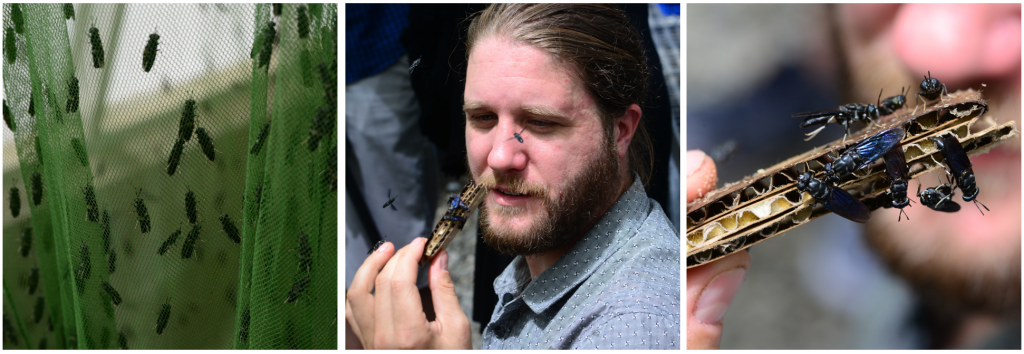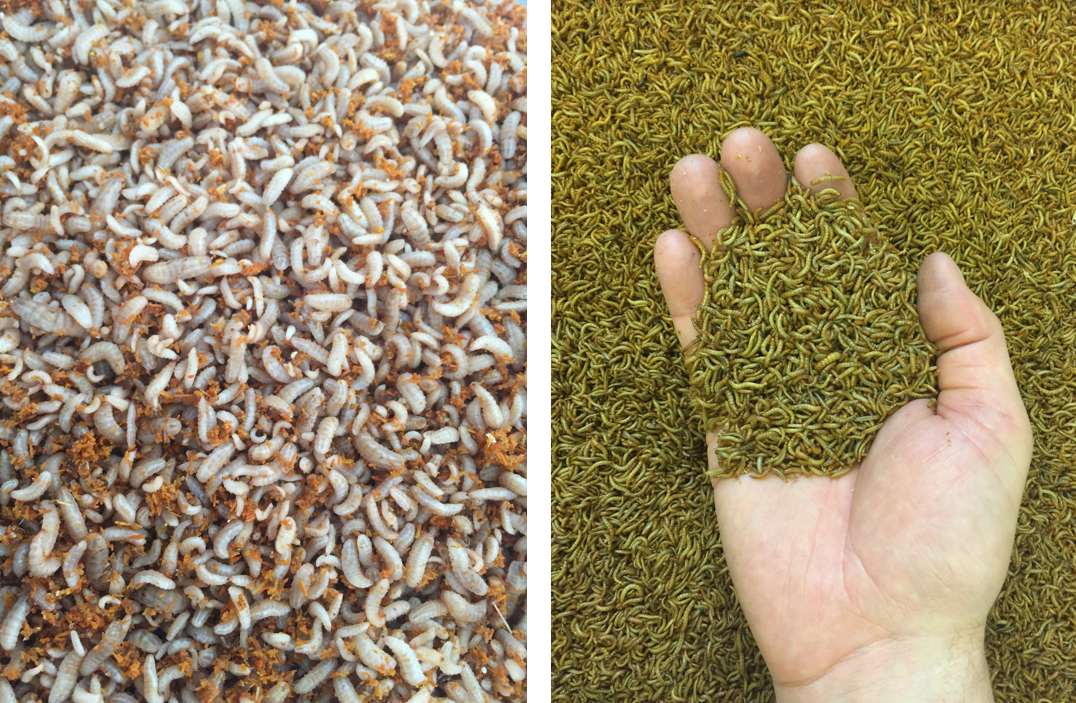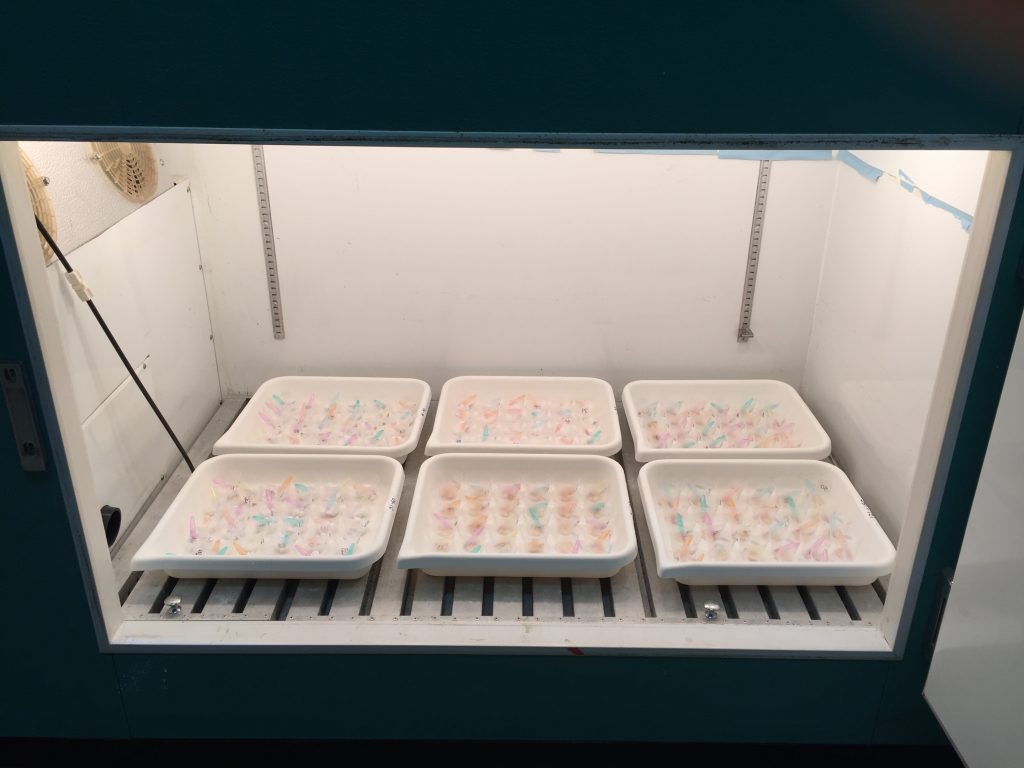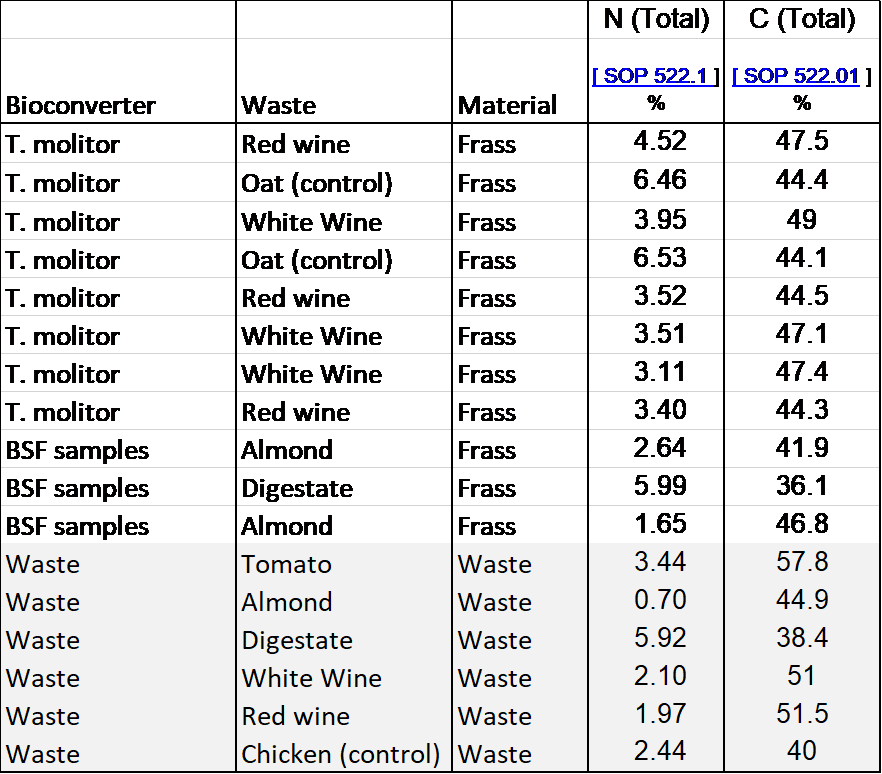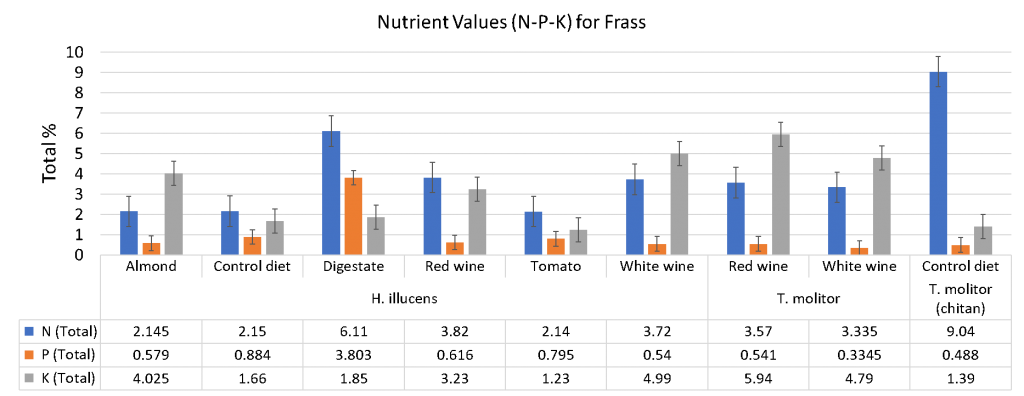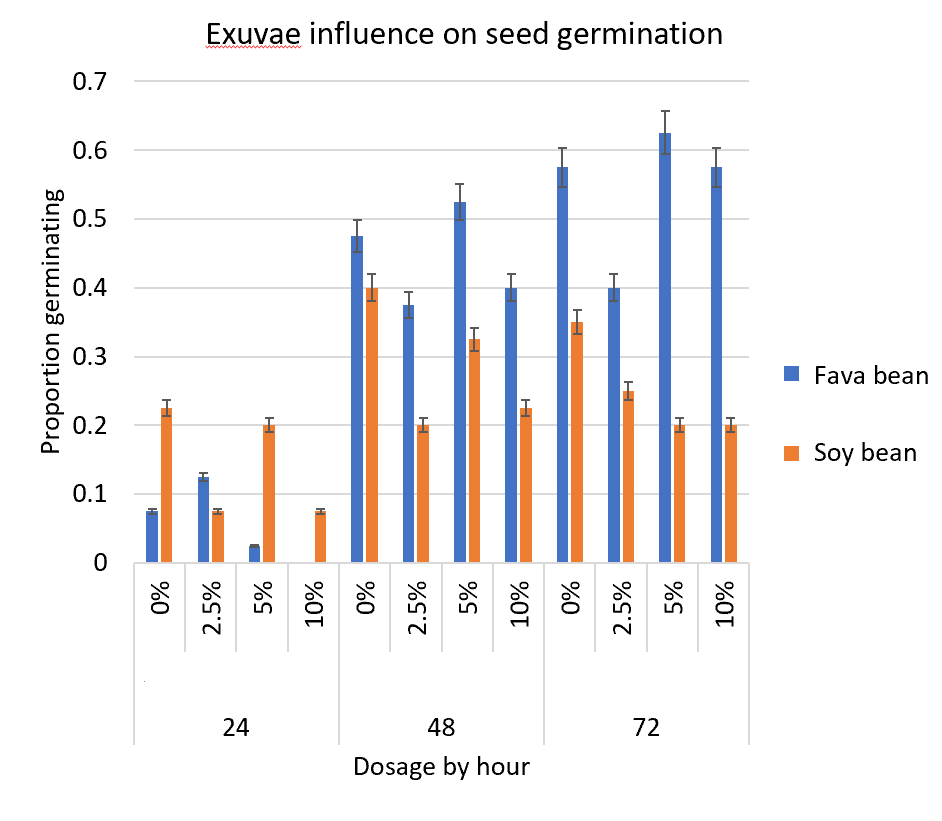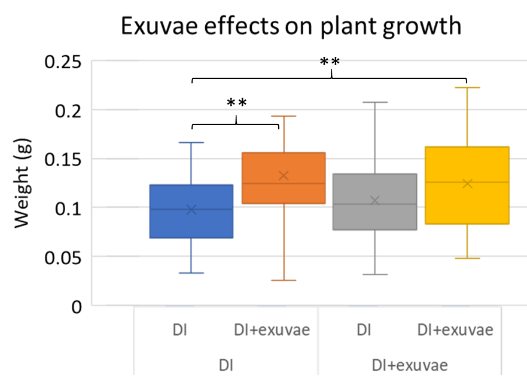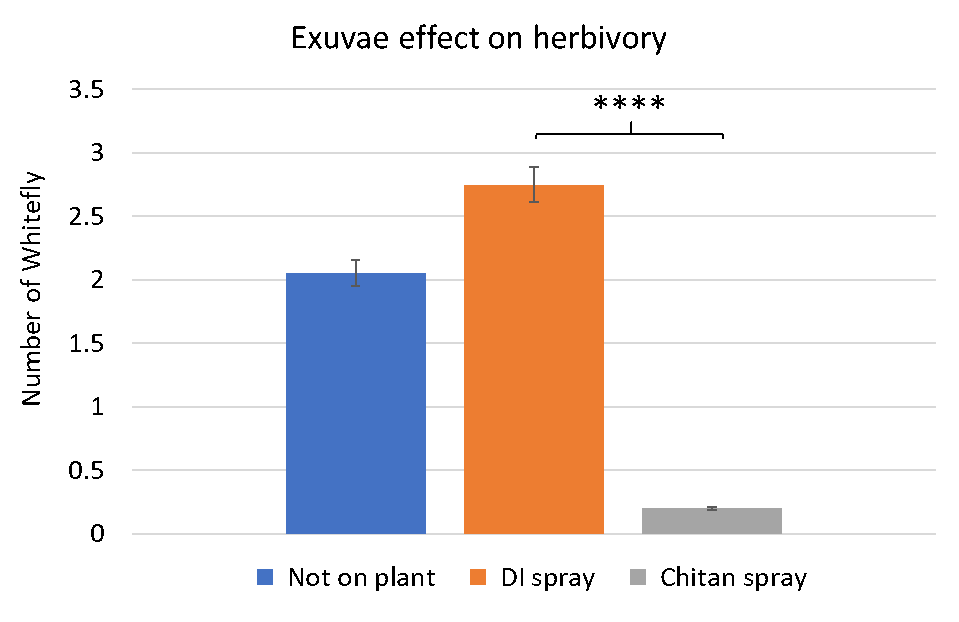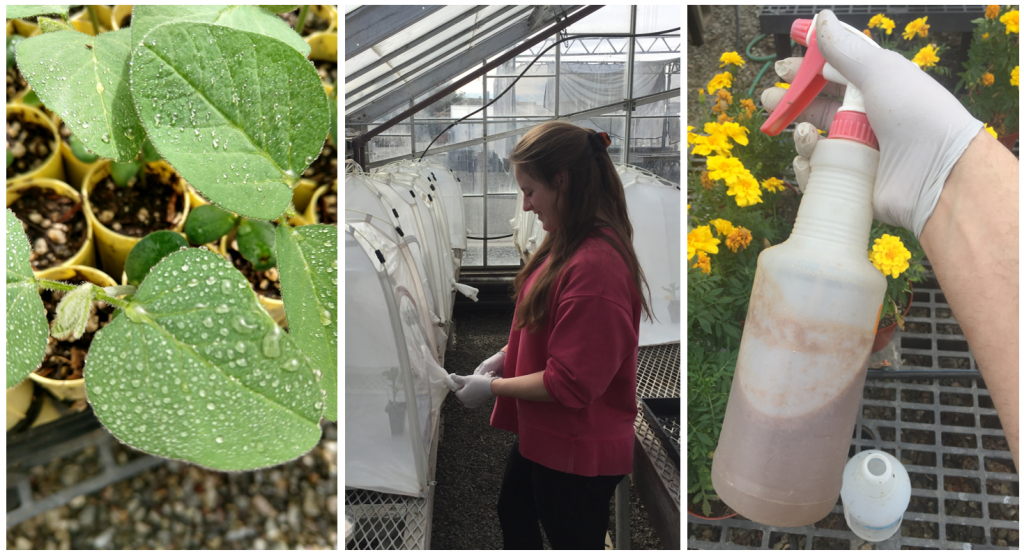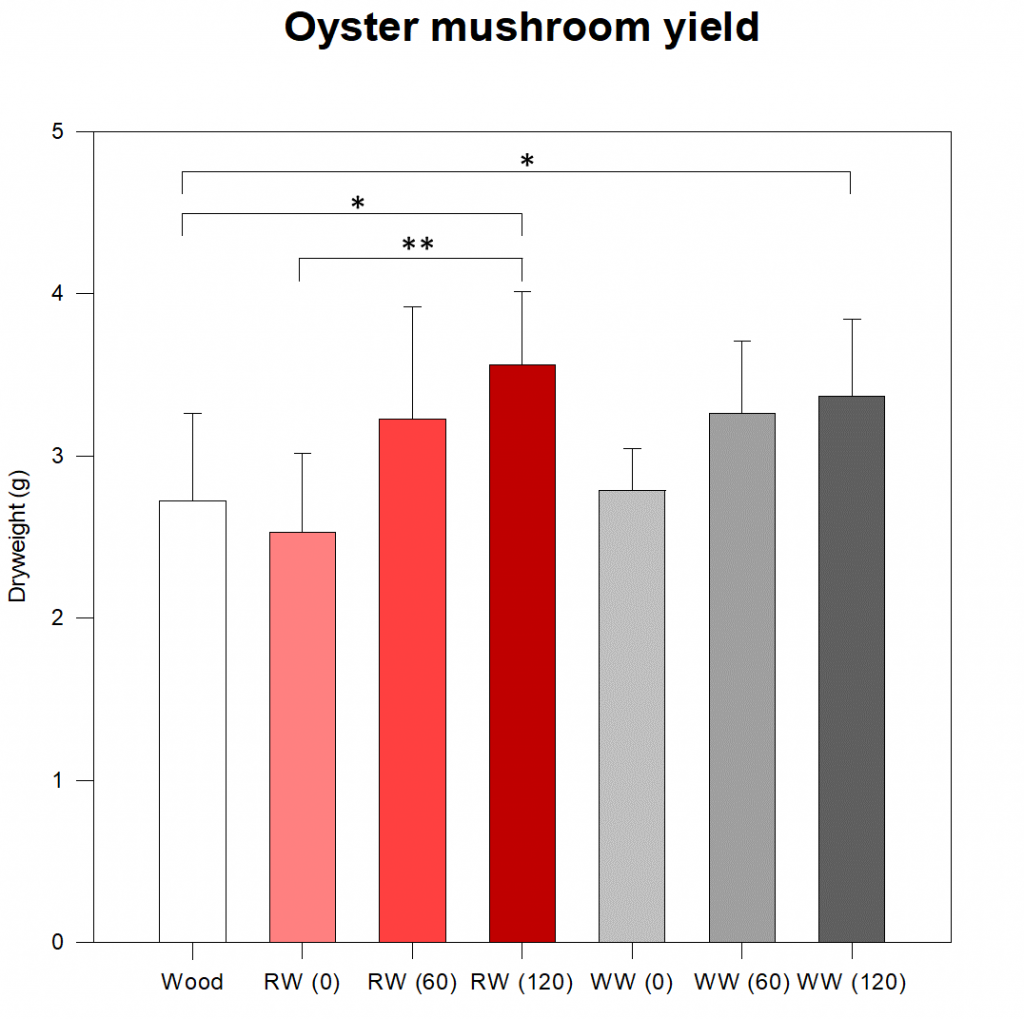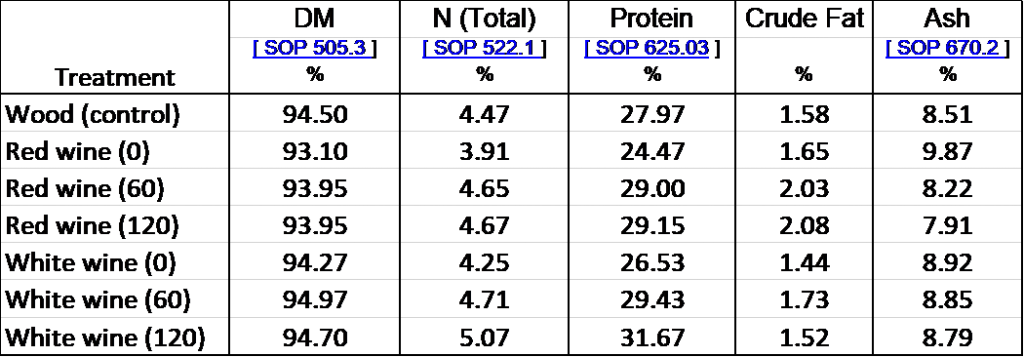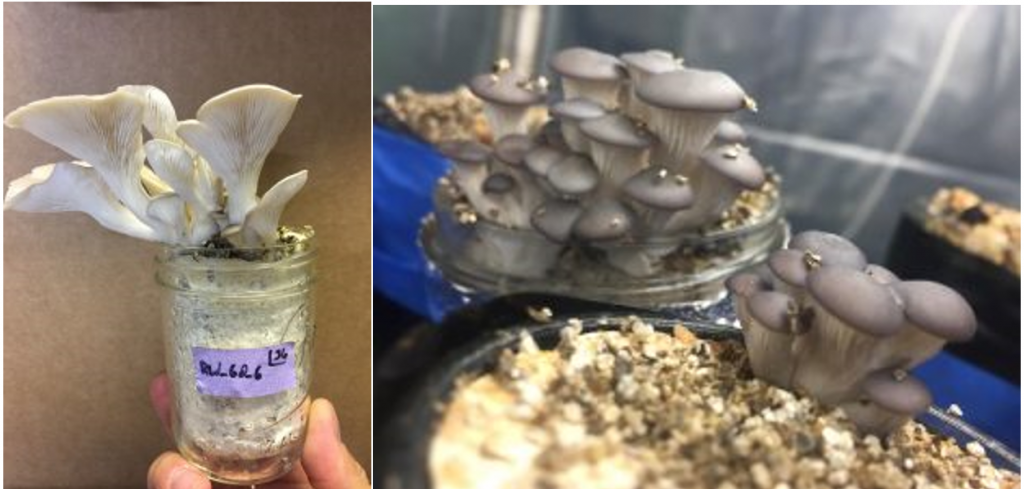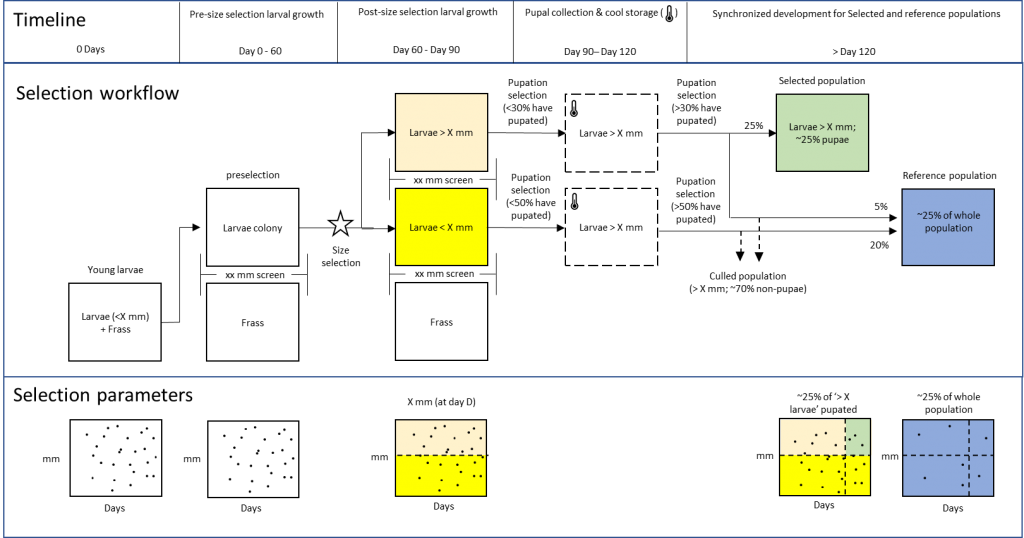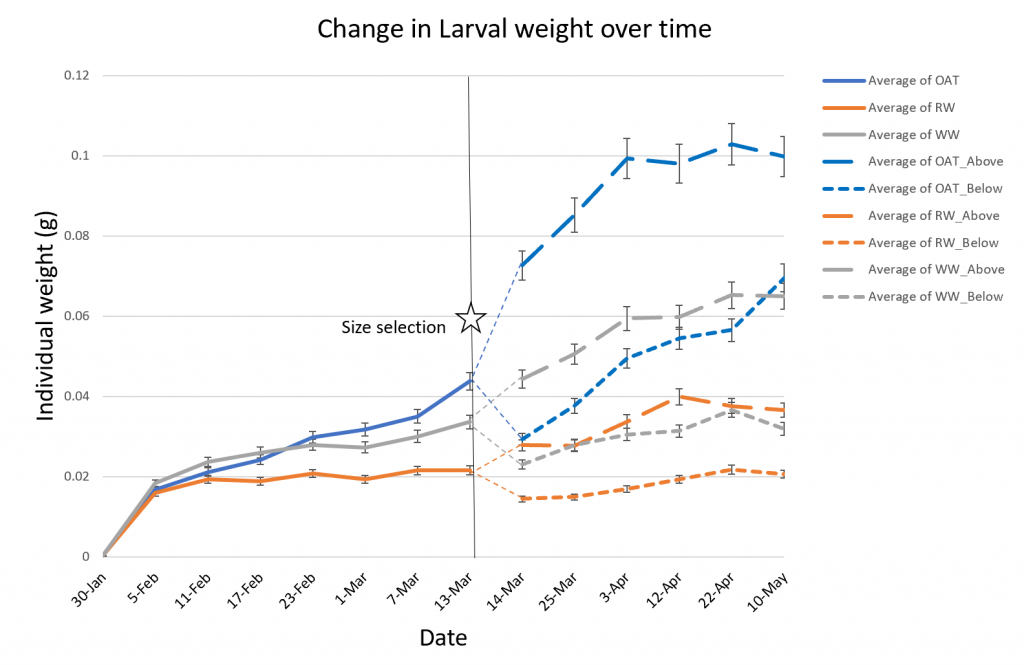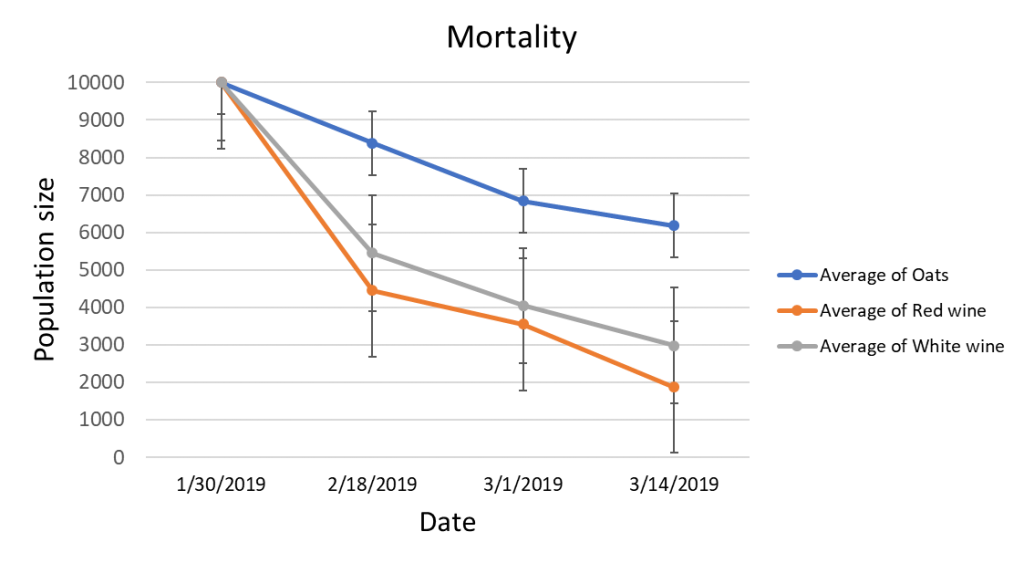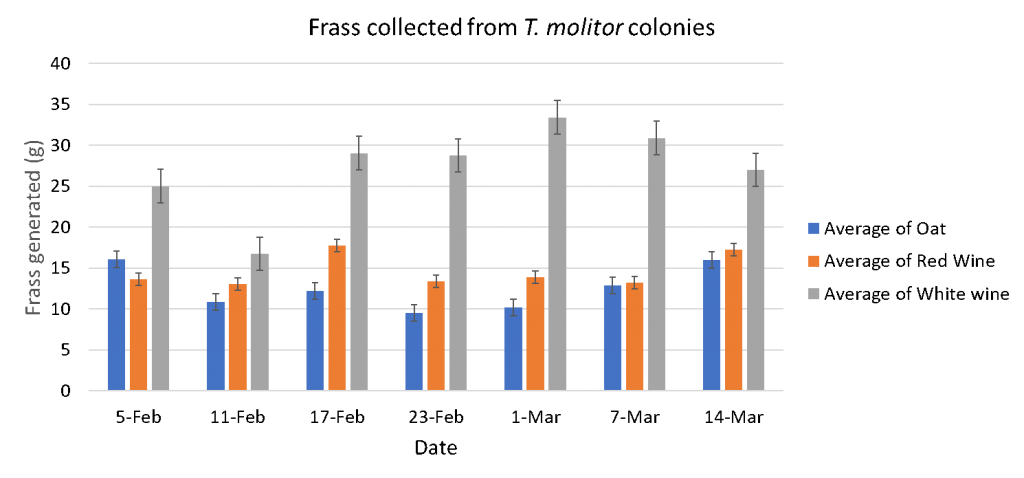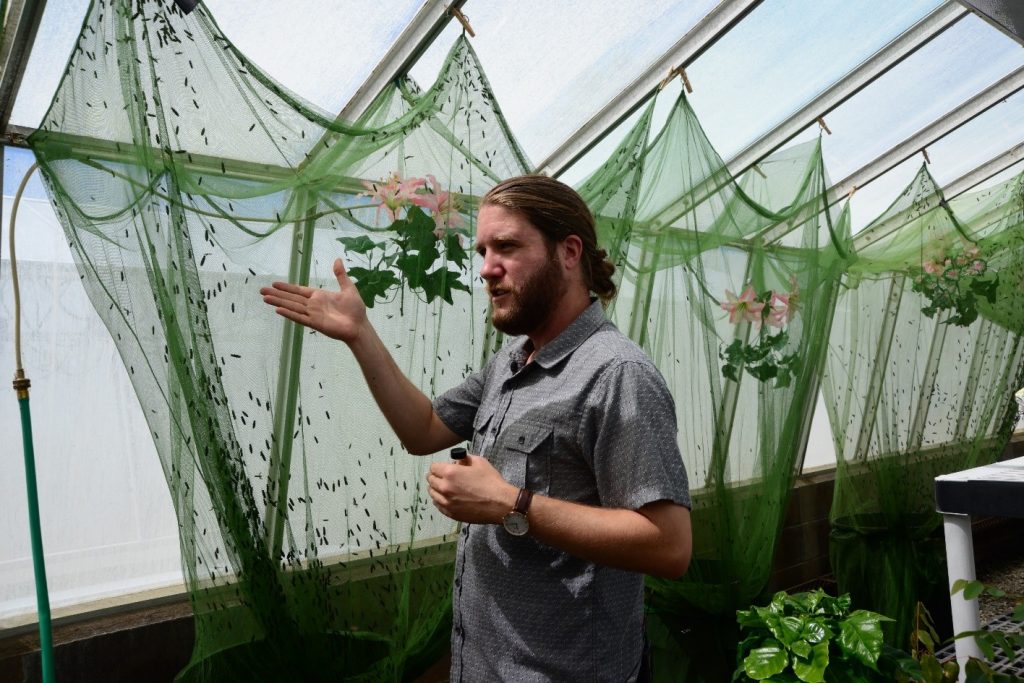Final report for GW18-041
Project Information
California produces over 400 crops, which in turn yield many more “organic waste residues” during downstream processing, such as fruit and vegetable pulp from juice industries. Some of these organic waste residues are used as substrate for mushroom production, compost, or as filler in animal feed. However, large portions end up in landfills and are considered a problem rather than an economic opportunity. As decomposers and herbivores, the diversity of insect species includes groups highly specialized in their ability to thrive on different organic substrates, and some of these substrates resemble waste residues from food processing industries. Crickets, cockroaches, soldier flies, bottle flies, and mealworms represent the most widely referenced species in studies of organic waste conversion. We argue that both insect discovery (testing of more species) and selective breeding are needed to further advance the potential of insects as converters of organic waste materials. We have data clearly suggesting that within a species, individuals show marked range in “adaptation” (measured as growth rate, nutrition uptake and therefore rate of bioconversion) when reared on specific organic waste materials. Such range in adaptation underscores the potential of selective breeding, and the overall project hypothesis is that we will identify and selectively breed specific species with significantly higher adaptation than strains of insects that are currently available commercially.
The stated goals of this project were to demonstrate how insect discovery and selective breeding can increase sustainable solid waste management practices. Specifically, (1) “mining” insect species diversity for new candidate bio-converters, (2) selectively breeding high performance strains, and (3) characterizing the potential for feeding poultry insects reared on different agricultural wastes. A major outcome from this project was increasing insight into which insect species and improved strains should be used for bioconversion, with insights specifically based on the nutritional and physical composition of the resulting insect by-products. In addition, we have been able to provide novel uses for insect derived by-products (fertilizers, immunostimulants, mushroom substrates) that will further make the burgeoning insect bioconversion sector economically viable.
Throughout the duration of this project, we have used the pursuit and cultivation of novel insect bioconverters as an effective means of recruitment for a new crop of incipient scientists. Under our flagship insect bioconversion program, we have expanded our team to include both interns and hired undergraduates. These students (Brian Cheng, Amanda Favilla, Zhijun Lu, Meredith Martin, and Curtis Carlson) not only have gained valuable experience within a scientific setting, both individually and as a team, but have each developed their own derivative projects alongside our main body of work. This has permitted them to gain knowledge spanning th whole scientific experience, including data collection and curation, analysis, and writing. Due to our combined efforts, several papers are expected to be produced from the work done on this project.
- Identify new species for organic waste residue conversion, with specific focus on rapid development, nutrition, high conversion ratios, easy extraction of insect body mass, and conversion of recalcitrant residues (those high in tannins or phenolics).
- Determine the composition and feed potential of insect biomass following rearing on different performing diet regimes.
- Establish improved lineages using applied evolutionary techniques, with target goals of increased body mass, development time, or fecundity. Improved lineages performance in these traits will exceed that of their initial populations.
- Work together with growers, extension specialists, and researchers cooperating in this project to disseminate findings and recommendations through newsletters, and symposia, and publications
Research
Materials and methods:
Objective 1- Identify new species for organic waste residue conversion, with specific focus on rapid development, nutrition, high conversion ratios, easy extraction of insect body mass, and conversion of recalcitrant residues (those high in tannins or phenolics).
Acquiring residues: We targeted 7 organic residues for bioconversion due to their local accessibility, large economic impact, and known nutritional and physical compositions. The 7 organic waste residues include — 3 almond residues (from 3 separate steps within the deshelling/dehulling process), white wine pomace, red wine pomace, tomato pomace, and agricultural enzymatic digestate. The original proposal also included 2 pistachio residues, olive pomace, onion solids, sugar beet solids, spent brewers mash, and whey. After working with these organic waste residues initially, we experienced insufficient quantities and/or logistical and storage difficulties—therefore justifying their elimination from our larger scale breeding programs. Our organic residues either come directly from the growers (Nickols Farms), processors (Campbells, via California Tomato Growers Association), and/or through intermediary colleagues in the Department of Food Science and Technology at UC Davis (i.e. campus winery).
Figure 1: (Left) collection of 50 gallons of red wine pomace from the UC Davis Campus winery. (Middle) Close up image of the red wine pomace, note the inclusion of stems, seeds, and skins. (Right) Semi-bioconverted red wine pomace. Week old black soldier fly larvae (Hermetia illucens) move through the residue in search of nutrients.
Bioconverters: We targeted 8 potential bioconversion species (4 beetles, 2 flies, 1 moth, and 1 crustacean), and compared them to 3 conventionally farmed insects (crickets, soldier flies, and meal worms). The original proposal also included 3 more bioconverters (2 novel, 1 conventional). However, difficulties in procuring colonies and additional considerations around allergenic responses led to conclude that they should be excluded from the study.
We considered candidate species to be competent bioconverters if their “conversion potential” was similar, or superior, to that of the 4 conventionally farmed insects. Conversion potential was defined by:
- preference for waste residue
- change in residue nutrients
- final body mass
- days to maturity
- nutritional value of bioconverter
- reduction of recalcitrant molecules such as tannins and phenols
Experimental design: Treatments included each species completing an entire life cycle on one organic waste residue. Each candidate was paired with a minimum of 6 different organic waste residues, with 10 replicates of each treatment. Candidate bioconverters were not matched to each of the targeted residues due to intuitive constraints of the life histories of the insects (i.e. fly maggots are unlikely to be reared on dry almond residues), instead we made intuitive decisions for pairing wastes with candidates. We had anticipated some success for these pairing because either, candidate species are close relatives to current bioconverters, they have preferable life histories well suited for waste conversion, or they are already cultured in mass but have not been targeted for providing a bioconversion service.
Research methods: The measurements evaluated were (1) preference for waste residue, calculated by the number of eggs females oviposit1; (2) the change in residue nutrients, calculated by the difference in macronutrient composition of organic waste residues before and after bioconversion2, This included crude protein, crude fat, phosphorus, calcium, ash; (3) final body mass; (4) days to maturity, (5) nutritional value of bioconverter3, This included crude protein, crude fat, phosphorus, calcium, ash, and (6) reduction of recalcitrant molecules such as tannins and phenols.
Materials and study site: Insects were reared in 2-quart plastic containers, stacked on shelving within environmentally controlled greenhouses. Containers were outfitted with humidity, temperature, and light sensors wired to environmental control units. Containers were housed in a 560-square foot growing space owned by UC Davis Entomology. This space has been designated as the flagship location for developing an insect bioconversion program at UC Davis.
Objective 2- Determine the composition and feed potential of insect biomass following rearing on different organic waste residues.
Research methods: Using bioconverters from objective 1, we determined the livestock feeding potential using industry-accepted metrics for characterizing nutrient content in poultry and livestock diets. This included crude protein, total nitrogen, crude fat, acid detergent fiber, total digestible nutrients, and ash. This data is useful to predict the metabolizable energy of the insect biomass in a poultry diet (according to the model of Garcia et al.) (as an example of one feed application for the biomass).
Young larvae from our colonies were reared on multiple agricultural waste residues (See table 1 & Figure 2). Their biomass was extracted and dried to determine the livestock feeding potential, and their separated frass (insect manure) was evaluated for its 1) fertilizer potential (N-P-K); 2) feed potential (H. illucens frass is uses as a feed in freshwater prawn in Ohio (Tiu 2012)); 3) immunostimulation; 4) and use as a mushroom substrate.
Figure 2: (left) Bioconversion trials to produce insect meal and frass (insect manure). Image includes H. illucens feeding on chicken feed (top), white wine pomace (second from top), almond hulls (third from top), tomato pomace (bottom); (Right) oven fried samples of meal and diets ready to be sent to UC Davis analytical chemistry laboratory.
Objective 3- Establish improved lineages using applied evolutionary techniques, with target goals of increased body mass, development time, or fecundity. Improved lineages performance in these traits will exceed that of their initial populations.
Residues: Based on the results from Objective 2, we targeted 4 organic waste residues (almond, white wine pomace, red wine pomace, tomato solids).
Bioconverters: We aimed to bred 2 conventional converters (T. molitor and H. illucens). However, but to the enormity of starting a breeding operation in one year we only have data for T. molitor.
Experimental design: We formed 6 large colonies (10,000 individuals) for three diets (Oat (control), white wine, and red wine). Each generation, we selected ~25% of the population displaying a directional extreme of a preferred trait (body size and development time).
To select for body mass, we manually selected the largest individuals of that generation using a 1.68mm sieve after ~45 days of development.
To select for development time, we manually selected the first emerging pupae equivalent to ~25% of the parental population, excluding the other.
We aimed to artificially select a single trait over 5-6 generations, recording each generations expression at this trait. We determined selecting ~25% the population because this allows the necessary recombination of genes for high diversity, while maintaining a strong and consistent selection to guide their evolution (following artificial selection experiments in Beldade et al.).
Materials and study site: Colonies were reared in 14-quart plastic containers, stacked on shelving within environmentally controlled grow tents. Tents were outfitted with humidity, temperature, and light sensors wired to environmental control units. Insects were housed in a 560-square foot growing space owned by UC Davis Entomology.
Figure 3: (Left) H. Illucens adults in the “love cage”, where they mate and produce eggs for the next generation. (Middle) Trevor Fowles, inspecting an egg trap, whist surrounded by flying H. ILLUCENS; (Right) Image showing a close up view of an egg trap, with female H. Illucens laying eggs in the crevasses.
Objective 4- Work together with growers, extension specialists, and researchers cooperating in this project to disseminate findings and recommendations through newsletters, and symposia, and publications.
To complete this objective, we established three avenues of public interaction:
- Online engagement; We have been featured on an online newsletter about food waste.
- Outreach; Partnering with the Food Loss and Waste Collaborative we have presented our findings as part of a symposium on food waste and agricultural sustainability.
- Publications; We written about the important role insects can play in sustainability and agriculture, A review on the subject, which articulates how this information fits into the greater bodies of scientific work and a book chapter (in print) illustrating the landscape of the insect bioconversion field and what is needed to make this tool a more efficient agricultural waste management solution.
Objective 1- Identify new species for organic waste residue conversion, with specific focus on rapid development, nutrition, high conversion ratios, easy extraction of insect body mass, and conversion of recalcitrant residues (those high in tannins or phenolics).
Results:
Of the 14 originally proposed insect species, we considered two to be competent bioconverters on our target wastes: 1) the black soldier fly (Hermetia illucens) and 2) the yellow mealworm (Tenebrio molitor). For H. illucens, all 7 wastes can be bioconverted well enough to be used to breeding trials. For mealworm, only two waste residues are suitable (white and red wine pomace). Other waste resulted in too high a mortality when scaling up to mass rearing. Surprisingly, and of notable consideration, mealworm bioconversion of white wine pomace yields cleaned seeds in their frass. Unlike red wine pomace, in which seeds and skins are fermented, white wine pomace seeds still retain oil that can be extracted. Meaning, mealworms are an unexpectedly efficient and cheap seed extractor.
Two issues were faced in the pairing of novel candidates to agricultural wastes. The primary issue facing candidate species was overcoming the first critical obstacle—completing an entire life cycle on one organic waste residue. As many of the wastes used in this project are secondary co-products of downstream food processing, they are naturally devoid of many essential nutrients. These nutrients are extracted along the food production system, as such we believe some of the species chosen as candidates were unable to handle the stress and often resorted to cannibalism. Alternatively (for wet, nutrient rich wastes), these species could not handle the intense bacterial competition (which H. illucens appears well equipped to handle). The second concern we encountered was of some of our teams allergenic response to the candidate species, specifically the Indianmeal moth. For these reasons, two species moved on to our breeding program
Figure 4: (Left) Black solder fly larvae devouring tomato pulp; (Right) Mealworms extracted from white wine pomace after size sorting and selection)
Figure 5: Mealworm feeding trials inside a temperature-controlled environment.
In lieu of the shortage of new bioconverters making their way to breeding trials, we decided to experiment with edible oyster mushrooms as an additional, non-arthropod bioconverter. During this project we have successfully grown mushrooms on 5 of the waste streams, in quantities that warrant further investigation. Preliminary data suggested they perform better on the bioconverted waste remains. Meaning, we can produce two pulses of different proteins from the same waste source—first with insect bioconversion, and second using their manure(frass) as a mushroom substrate. Further, the remaining matter that has been serially digested by insects and mushrooms may be more suitable as a compost amendment. This increases the value of the proposed method, and will factor into its suitability as a bioconverter. (see below; Objective 2)
Objective 2- Determine the composition and feed potential of insect biomass following rearing on different organic waste residues.
Results:
Overall, the results of objective 2 can be divided into two components. First, there is the feed analysis data from the waste-bioconverter pairings. This information may be used to calculate several values used in formulating animal feeds. For example, using the acid detergent fiber (ADF %) we have provided, one may calculate the Digestible Dry Matter (DDM), which is a value used to estimate the percentage of forage that is digestible in a feed mix. Likewise, other values provided are informative in how frass and meal may be used in feed formulation. For example, the total digestible nutrients (TDN) gives the sum of the digestible fiber, lipids, protein, and carbohydrate available if used as a diet. TDN is directly related to digestible energy and used to under-predict the feeding value of concentrate relative to forage. Therefore, the result of this first component of results is informative to the end user in a myriad of way, but relevant only in how they would seek to use the data. The information from the feeding trials may be found in tables 1-4. Note, that from the insect production frame of mind, some of these waste pairings may represent unique opportunities, for example T. molitor and red wine produce an insect meal that is 73% protein by dry weight, whereas a pairing of H. illucens and almonds is in the low 20%. Considering red wine waste is one of the cheapest and most plentiful wastes in California, such a high protein end-product may be of considerable interest.
Table 1: The feed value of the “raw” agricultural wastes used to rear our insect colonies. Note, two controls were selected one for T. molitor (oat) and another for H. illucens (Chicken feed).
Table 2: Carbon to nitrogen ratios for the agricultural wastes fed to the bioconverters and the resulting frass post-bioconversion. Note, bioconversion results in an insect manure (frass) that is higher in nitrogen, with less carbon.
Recent research using H. Illucens has suggested that managing carbon to nitrogen ratios (C:N) can enhance bioconversion of highly lignocellulose wastes (Palma et. Al 2019). However, this management approach comes at the cost of reducing larvae amino acid content. Amino acid contents are extremely valuable to poultry farmers, with methionine being the amino acid or highest interest. As a starting point for discussing the results of our waste-to-bioconverter pairings with H. Illucens and T. Molitor, here we have provided the C:N for both the waste that is used as a diet for the bioconverters, as well as the resulting frass. It is of note that for C:N ratios of each of the wastes measured before and after bioconversion, the total % of nitrogen increases, while the total % of carbon decreases. The highest change occurred in the bioconversion of red wine by T. Molitor (+2.847% N, -6.2% C). This is interesting considering red wine pomace is an exceptionally ‘hard’ material to bioconvert (see below).
Table 3: Feed value analysis of the insect meals derived from different agricultural wastes.
Table 4: Feed value analysis of the insect frass derived from different agricultural wastes.
|
Hyperlinked List of UC Davis Analytical chemistry SOP's |
|
|
Ash |
|
|
C (Total) |
|
|
Dry matter |
|
|
K (Total) |
|
|
N (Total) |
|
|
N (Total) |
|
|
P (Total) |
|
|
Protein |
|
Table 5: Table of the standard operating procedures given by the UC Davis Analytical Chemistry Laboratory for procedures used to gather the data for tables 2-4.
The second component of the data from objective 2 are the downstream applications of the by-products generated from the feeding trials, specifically;
1) Frass as fertilizer (figure 5); Note that exuvae (chitan; shed exoskeletons of larvae) has the highest nitrogen composition. Which is typically a valuable component in fertilizers. Exuvae is generated in large quantities when cultivating mealworms, and is considered a low-value by-product, considering the results of the NPK analysis we explored several uses for this material (see below).
2) Influence of exuvae on seed germination (figure 6); We investigated the germination of two species of dicots, soy bean and fava bean. At higher concentrations (10% exuvae) germination was reduced in soybean, but higher in fava bean relative to the control. This is part of an ongoing undergraduate project investigating the fungal influences of this interaction that may be reducing soy bean germination.
3) Influence of exuvae on plant growth (figure 7); Considering the relatively high nitrogen levels of exuvae, we hypothesized that this by-product may be used as a soil fertilizer. We germinated seeds in either deionized waster (DI) or a 10% DI+exuvae mixture. As seeds were planted and matured, we gave them either deionized waster (DI) or a 10% DI+exuvae mixture. This four factorial design gave us four treatments from which to explore exuvae effects on plant growth. After 14 days we weighted and dried the plants. Plants given a 10% DI+exuvae mixture to both germinate and grow grew more than DI water only (p-value is .008029). Plants germinated in DI water but given a 10% DI+exuvae mixture for watering were larger than DI only (p-value is .003515). The watering regime appears to be more important than the germination conditions.
4) Influence of exuvae as an immunostimulant (figure 8 & 9); Plants sprayed with a 10% DI+exuvae mixture one hour prior to whitefly infestations exhibited far less infestation than plants only sprayed with DI waster (p-value is < .00001). However, there was no difference between the number of whitefly on non-sprayed plants and not on plants at all. Such a strong effect warrants further investigation and is part on an ongoing undergraduate project.
5) Use of frass as a component of mushroom substrates (figure 10 & 11; table 6;) Here we presented 60 grams of white and red wine waste to three population density treatments of T. molitor (0, 60, 120). Larvae were able to bioconvert the waste for 35 days, whereby the total remaining material was used to supplement a wood media for mushroom growth at a ratio of 1:1. We found that the more bioconverted the waste, the higher the yield of mushrooms (P < 0.01). With 9% red wine frass content of media by weight giving the highest yield. Red wine frass gave a higher yield than white wine frass. This may be due to a higher protein profile (Table 4).
Figure 5: Standard fertilizer nutrient values (N-P-K; Nitrogen-Phosphorus-Potassium) for co-products of bioconversion. All but one of the bar graphs are derived from insect frass. One (far right) is derived from exuvae—the shed exoskeletons of T. Molitor. Note, the exuvae has the highest nitrogen value.
Figure 6: Influence of exuvae on the germination of two dicots, soy bean and fava bean.
Figure 7: Influence of exuvae added to the watering regimes of fava bean.
Figure 8: Influence of exuvae on the immunostimulation (plant defenses) of fava bean.
Figure 9: (Left) Fava bean sprayed with exuvae:deionized water (1:9); (Middle) Undergraduate, Meredith “Molly” Martin, setting up and spraying fava beans inside protective cages; (Right) bottle containing the exuvae:deionized water spray
Figure 10: Dry weight yields of oyster mushrooms grown on substrates bioconverted by variable population densities of T. Molitor. (Wood = Cherry wood control; all other treatments are a 1:1 mixture of bioconversion treatment and cherry wood; RW(0) = red wine pomace added to cherry wood; RW(60) = 60 mealworms per 60 grams of red wine pomace and cherry wood; RW(120) = 120 mealworms per 60 grams of red wine pomace and cherry wood; RW(0) = white wine pomace and cherry wood; WW(60) = 60 mealworms per 60 grams of white wine pomace and cherry wood; RW(120) = 120 mealworms per 60 grams of white wine pomace and cherry wood. Note, greater densities, and therefore more bioconversion of material yielded higher mushroom growth.
Table 6: Feed value analysis of the mushrooms grown on substrates derived from two wine wastes.
Figure 11: two images of oyster mushrooms growing on bioconverted wine pomace
Objective 3- Establish improved lineages using applied evolutionary techniques, with target goals of increased body mass, development time, or fecundity. Improved lineages performance in these traits will exceed that of their initial populations.
Results:
Due to several issues beyond our control (failing fans in the greenhouse and a rat infestation eating the adults flies at our first location) the data for fly production is not currently usable and we are currently restarting that breeding effort. However, the T. molitor colonies housed at a separate location remained intact. The data for the growth of the colony is provided in figure 14. Of particular note is the unexpected increase in longevity of the larvae when being cultivated on a new host substrate. Typically, T. molitor will complete a lifecycle in less than 60 days. However, the colonies on the white and red wine wastes exceeded 120 days for a single life cycle. This means there was the potential to have asynchronous development between and among our replicates and treatments. To avoid this, we developed a flowchart/model (figure 13) where the final stages of the larvae are chilled so that upon having the top ~25% reach pupation they may be returned to normal conditions and synchronously breed.
We found that white and red wine wastes experience a significant decline in population, 70% and 80% mortality, respectively (figure 15). However, the ancestral diet leads to 40% decline in population, which was considerably higher than expected.
For the larval weight change among the treatments, the ancestral diet lead to the greatest gain of weight, followed by white wine, with red wine diets eliciting the lowest wait gain over the experiment (figure 14). Interestingly, white wine diets elicited the highest bioconversion and generation of frass (figure 16). Often twice as much as the other two diets, with red wine eliciting slightly more bioconversion and frass generation than the ancestral diet.
The data provided here is for the first generation. The following generation, that has been size selected is currently being cultivated. The data presented here will be used to compare how strong an influence artificial selection is in guiding growth and development on the novel agricultural waste diets.
Figure 13: Framework underpinning a “tandem selection method” of T. Molitor using both size selection (White star) and pupation date selection. Note, tandem selection will cull large portions of the populations while only aiming to target two traits. Care needs to be given to what trait, and from how many individuals, so that populations are not decimated.
Figure 14: Change in larval weight over time on T. Molitor bioconverting three different diets: Oat/control= blue; 2) RW= Red wine; 3) WW= White wine. Note, on March 13 there is a size segregation, where the colony gets split in two using a 1.68mm sieve. The large dashes are above the sieve, the smaller dashes are below.
Figure 15: Mortality of the three treatments of T. Molitor. Note, the control (ancestral) colony is least variant and highest performing.
Figure 16: Frass collected throughout the duration of the breeding experiment. Note, 1) white wine is consistently the higher frass producer. 2) All the frass presented here is before size segregation. Considering the drastic differences in size, our team decided not to include further data.
Objective 4- Work together with growers, extension specialists, and researchers cooperating in this project to disseminate findings and recommendations through newsletters, and symposia, and publications.
To complete this objective, we established three avenues of public interaction:
- Online engagement; We have been featured on an online newsletter about food waste
- Outreach; Partnering with the Food Loss and Waste Collaborative we have presented our findings as part of a symposium on food waste and agricultural sustainability.
- Publications; We written about the important role insects can play in sustainability and agriculture, A review on the subject, which articulates how this information fits into the greater bodies of scientific work and a book chapter illustrating the landscape of the insect bioconversion field and what is needed to make this tool a more efficient agricultural waste management solution.
- [Fowles, Trevor M., and Christian Nansen. "Artificial selection of insects to bioconvert pre-consumer organic wastes. A review." Agronomy for sustainable development 39.3 (2019): 31.];
- [Fowles, Trevor M., and Christian Nansen. "Insect-Based Bioconversion: Value from Food Waste." Food Waste Management. Palgrave Macmillan, Cham, 2020. 321-346.]
Figure 17: Trevor Fowles, discussing fly husbandry, breeding, and sustainability with students (off camera).
Works cited:
- Tiu, L. G. "Enhancing sustainability of freshwater prawn production in Ohio." Ohio State Univ. South Cent. Newsl. Fall 11.4 (2012).
- Palma, Lydia, et al. "Managing high fiber food waste for the cultivation of black soldier fly larvae." npj Science of Food1 (2019): 1-7
- Nansen, C. & Phillips, T. W. Ovipositional responses of the Indianmeal moth, Plodia interpunctella (Hübner)(Lepidoptera: Pyralidae) to oils. Ann. Entomol. Soc. Am. 96, 524–531 (2003).
- Ramos-Elorduy, J., González, E. A., Hernández, A. R. & Pino, J. M. Use of Tenebrio molitor (Coleoptera: Tenebrionidae) to recycle organic wastes and as feed for broiler chickens. J. Econ. Entomol. 95, 214–220 (2002)
- Garcia, R. A., Phillips, J. G. & Adeola, O. Improved prediction of meat and bone meal metabolizable energy content for ducks through in vitro methods. Poult. Sci. 91, 1854–1859 (2012).
- Beldade, P., Brakefield, P. M. & Long, A. D. Generating phenotypic variation: prospects from ‘evo‐devo’ research on Bicyclus anynana wing patterns. Evol. Dev. 7, 101–107 (2005).
Research Outcomes
Education and Outreach
Participation Summary:
The first year of this project included acquisition of bioconverters and crop waste residues, followed by trials to test their compliance against established bioconverters. In the second year, breeding occurred using the targeted bioconverters, T. Molitor and H. Illucens. In addition, secondary and tertiary uses of the co-products of bioconversion were tested. All of this is relevant information, albeit time consuming. We are afraid the time frame presented in the initial proposal was rather ambitious for the outreach section initially proposed. This is particularly true given that the results of breeding that we intended to disseminate cannot occur if colonies take 3x-5x times longer to develop on the novel feed sources (ag wastes) than predicted. While we are confident that there will be publishable data derived from the work of this project, and that the colonies will adapt to the new wastes in time, we are obliged to present the contingency outreach methods we employed to inform the greater public.
- We have published two papers regarding the topic of insect cultivation, breeding, and agricultural wastes.
- A review on the subject, which articulates how this information fits into the greater bodies of scientific work efficient agricultural waste management solution.
- Book chapter illustrating the landscape of the insect bioconversion field and what is needed to make this tool an more efficient agricultural waste management solution.
- Our team has presented multiple time at the food waste collaborative at UCD Davis https://foodwastecollaborative.ucdavis.edu/
- 5 papers are in progress that are derived from the tangential work of undergraduate interns and hires. Each of these students must complete some form of written work to graduate. Therefore, this project has been an invaluable tool for their success as scientists and peer reviewed publications of this work are not far off.
- Trevor Fowles has participated in several elementary classroom “career day” events—bringing the knowledge and inspiration of science to a potential new crop of incipient scientists about the nascent field of insect bioconversion/farming.


